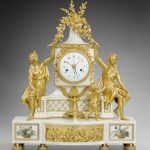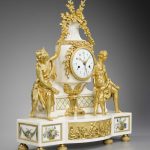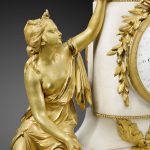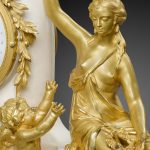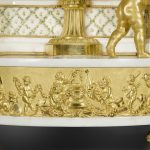A Robert Robin painted Carrara marble mantel clock
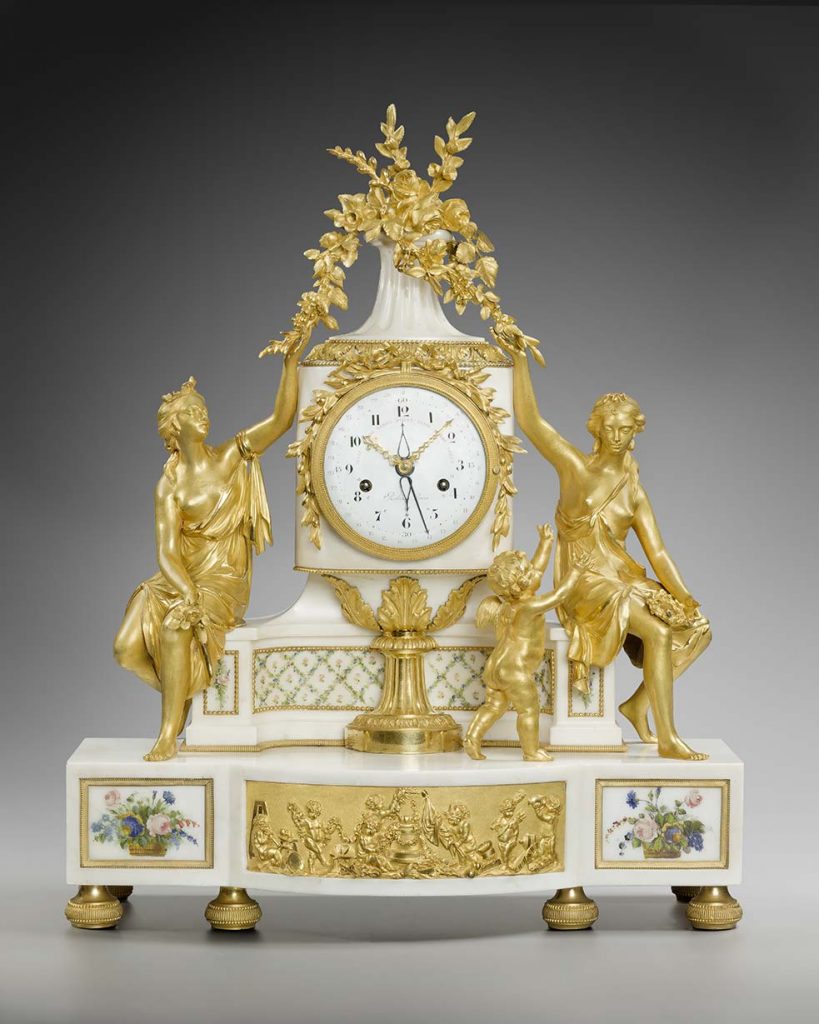
A Louis XVI gilt-bronze mounted painted white Carrara marble mantel clock,
the dial signed Robin à Paris,
the enamel signed by the enameller Coteau – circa 1785
Robert Robin (1741-1799), maitre 21 November 1767
Joseph Coteau (1740-1812)
Height: 62.5 cm. (24 ½ in.) Width: 50.3 cm. (19 ¾ in.)
Depth: 19.3 cm. (7 ½ in.)
The circular dial indicates the hours and minutes with Arabic numerals by means of gilt brass hands and the days of the month and days of the week with their corresponding zodiac symbols by means of blued steel hands. The circular movement has an anchor escapement and silk thread suspension and chimes the hours and half hours by means of a count-wheel on the back plate.
Two classical maidens flank a central vase incorporating the movement and drape it with floral garlands while a putto looks on. The plinth base is decorated with panels of painted baskets of flowers and festoons and surround a central gilt bronze relief plaque depicting putti emblematic of the liberal and martial arts surrounding an altar to love.
Provenance
Raphael Collection, sold Christie’s London, 18 May 1927, lot 108
Founes Collection, sold Paris, 27 June 1935, lot 76
Comparative Literature
Other clocks of this model with the marble painted include:
- One formerly sold by my gallery, illustrated in P. Kjellberg, Encyclopédie de la pendule Française, Paris, 1997, p. 256 D (the dial unsigned)
- One sold Etude Rouillac, Vendome, 25 April 1993 (signed Drouot à Paris)
- One sold from the collections of Maurice Ségoura, Christie’s New York, 19 October 2006, lot 29 (signed De Belle)
- One sold Artcurial, Paris, 8 July 2014, lot 92 (signed Filon à Paris)
A model with the painted marble replaced by gilt bronze mounts is in the Victoria and Albert Museum, London (inv. M.31-1934), illustrated in La Pendule Française dans le monde, 2, Paris, 1981 (5th edn.), p. 36 (the dial unsigned).
Robert Robin (1741-1799), maitre on 21 November 1767
Robin belongs to a very small group of clock-makers whose innovations and work made significant contributions to the development of the measurement of time. He was Marie-Antoinette’s favorite clock-maker; the 1793 inventory of her collections lists no fewer than 23 clocks by him. In the course of his career, he accumulated an exceptional number of titles and positions with the Royal family and subsequently with the Revolutionary governments:
Marchand-Horloger Privilégié du Roi 1763
Horloger du duc de Chartres 1778
Valet de Chambre-Horloger Ordinaire du Roi 1783
Valet de Chambre-Horloger Ordinaire de la Reine 1786
Horloger de Monsieur 1785
Horloger de la République 1794
Horloger du Directoire 1796

